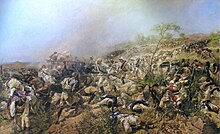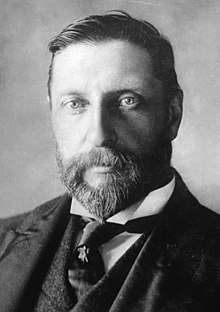King Solomon's Treasury
King Solomon's Treasury , also King Solomon's Diamonds (English original title King Solomon's Mines ), is a novel by H. Rider Haggard from the year 1885. The work was based on the model of Robert Louis Stevenson's Treasure Island (1883) and tells the adventurous journey of the hunter Allan Quatermain in then undiscovered parts of Africa .
background
Haggard had lived in South Africa from 1875 to 1880 and was "fascinated by the landscape, wildlife, tribal society and the mysterious past." King Solomon's Mines was his first novel, allegedly written because of a bet for five shillings that he would be a novel that was as good as Stevenson's Treasure Island . The publication fell in the period of late Victorian imperialism ; The supposed duty of the British is often reflected in contemporary literature, "to bring the light of civilization to the dark places of this world through trade and mission, if necessary also through the use of military force."
action
On a sea voyage from Cape Town to Durban , the big game hunter Allan Quatermain meets two compatriots, the retired lieutenant of the Royal Navy John Good and the wealthy nobleman Sir Henry Curtis. The latter asks Quatermain to lead him and Good on an expedition to the undiscovered inland to look for Curtis' missing brother. In fact, Quatermain has already met him and knows that he has set out on the dangerous search for the legendary mines of King Solomon . Quatermain also has a map with accompanying letters that should show the way through the desert and across a mountain range to the entrance of the mines. After initial hesitation - Quatermain repeatedly says of himself that he is "a cautious, indeed a fearful man", even if he shows great drive - the big game hunter agrees to Curtis' proposal and negotiates a handsome reward and an annuity for his own Son in case he doesn't survive the expedition himself.
Once in Durban, Quatermain puts together the equipment for the trip and hires several locals. Finally, a man named Umbopa introduces himself to the English, who shows a particular interest in the destination of the trip and can take on Curtis with his muscular build. Since he shows great self-confidence, does not ask for payment and his origin remains unclear, Quatermain is suspicious, but Curtis decides in Umbopa's favor.
The group set off at the end of January and set out on the more than 1,000 mile route to the starting point of the map on the Lukanga River . In a conversation with Curtis, who interprets Quatermain, Umbopa reveals that, like Curtis, he is of noble blood and may also be looking for a brother in the area beyond the desert and the mountains.
With significantly reduced luggage, the group sets off into the desert, some water carriers accompany them during the first few hours and then return to the last settlement. After two days and a distance of about 60 miles in scorching heat, the men almost reached the end of their strength at the waterhole marked on the map. From here you can also see the peaks of the mountain range that borders the desert and the flanks of the two mountains, according to Quatermain's estimate, over 5000 meters high, which are called "breasts of the Queen of Sheba " on the map . During the night the men march on and the day after that they reach the foot of the mountains. Her water supplies have been used up again, but this time she saves a large field of wild melons . The men continue the ascent and now have to suffer from extreme cold after the unbearable heat of the desert, which their tracker , the Hottentot Ventvögel (wind bird), finally falls victim to. The men have reached a cave mentioned in the letter accompanying the map and find the mummified body of a Portuguese who visited the land behind the mountains in 1590, but fell victim to a witch named Gagool. Shortly before his death he wrote or drew the letter and the card with his own blood. His servant managed to bring back the papers of the Portuguese's family. Centuries later, a member of this family paid with his life for an attempt to cross the desert as well, but previously passed the map and the letter on to Quatermain. The men now cross a high plateau and descend on the less hostile other side. You meet the path, which is called Solomon's Road on the map, and rest by a mountain stream. Here they are confronted by armed locals, the Kukuanas. They want to kill them, but when Good nervously moves his artificial teeth in his mouth, then takes them out and puts them back in, the locals are convinced that the travelers are ghosts. Good's monocle and the fact that he had only shaved off half of his beard on his first shave in several days when he was interrupted by the Kukuana warriors also add to this.
The tour group is escorted to Loo, the capital of Kukuanaland, and King Twala is shown. The king, disfigured by a wound and one-eyed, proves his tyrannical and bloodthirsty nature when he orders the death of a soldier who dropped his shield during the audience . Quatermain and his companions pretend to be travelers from the stars and show their superiority by demonstrating their firearms. Twala then approaches them with caution, but it turns out that there is still a witch Gagool, as she was called in the Portuguese's letter, to this day. She predicts a bloodbath.

Umbopa reveals himself to the English as Ignosi, son of the rightful king of Kukuanaland, whom his brother Twala murdered years ago. Umbopa's mother then fled the country with her son. Umbopa now wants to wrest the throne from his uncle Twala again and easily finds supporters among the Kukuanas who want to end Twala's cruel rule. Quatermain and his companions also pledge their support. There is no trace of Curtis' brother in Kukuanaland. The English prevent Umbopa's death at a barbaric ceremony during which political enemies and men whose property Twala desires are accused of witchcraft and killed by Gagool. During another ceremony, they save the girl Foulata and use a lunar eclipse, the date of which was recorded in Goods notebook, to underline Umbopa's claim to rule. Umbopa gathers his followers on a hill and succeeds in repelling the attack of the numerically superior army of Twala. In the final stand, Curtis cuts off Twala's head in a duel. Umbopa is crowned king.
The English force Gagool to show them the way into Solomon's mines. There they find large quantities of diamonds , but Gagool locks them behind a massive rock door, even if they themselves are crushed under the stone. The girl Foulata, who wanted to protect Quatermain and his companions, was previously fatally injured by her. The English hope to be saved at first, but then they find a trap door in the ground and escape through a cave system that is partially under water. You say goodbye to Umbopa and return on a different route through the desert. In an oasis they meet Curtis' brother, who was unable to continue traveling because of a broken leg. Together with him they cope with the last stretch of the road and get rich with the few but very valuable diamonds that they were able to bring back from the mines.
reception
The novel, initially rejected by various publishers, became a bestseller and “satisfied the keen interest in exotic countries”, although or precisely because it “portrayed a romantic rather than an authentic picture of African life.” The three Englishmen can, as “representatives of English civilization consciousness, gentlemen without fear and blame, who even in the moment of greatest danger do not move a face ”, Umbopa as noble savage . The influence of the novel was great, as Haggard's biographer Morton N. Cohen wrote, because "for many Englishmen, Africa became the Africa of King Solomon's Mines ". As a result, Haggard published several similar novels, for example Allan Quatermain and She (both 1887).
Film adaptations
- 1937: King Solomon's Mines
- 1950: King Solomon's diamonds
- 1978: King Solomon's Treasure
- 1985: Quatermain - In search of the treasure of kings
- 2001: Quatermain - The Treasure of Kings
- 2004: Quatermain and the Treasure of King Solomon
- 2008: Allan Quatermain and the Temple of Skulls
expenditure

English editions (selection)
- King Solomon's Mines . Cassell & Company, London 1885. (first edition)
- King Solomon's Mines . Oxford University Press, Oxford 2008, ISBN 978-0-19-953641-2 .
- King Solomon's Mines . Penguin Books, London 1994, ISBN 978-0-14-062123-5 .
- King Solomon's Mines . Penguin Books, London 2008, ISBN 978-0-14-143952-5 .
German translations
- Umbopa - King of Kukuanaland: The discovery of King Solomon's treasures in the dark continent. Translated by M. Strauss. Stroefer, Nuremberg 1888.
- Diamond mines of Africa: The discovery of King Solomon's treasures in the dark continent. Translated by M. Strauss. Stroefer, Nuremberg 1898.
- King Solomon's Treasury. Translated by M. Strauss. Stroefer, Munich 1910.
- The Treasures of King Solomon: Adventure in the Dark Continent. Translated by P. Kent. Thienemann, Stuttgart 1954.
- King Solomon's Treasury. Translated by Volker H. Schmied. Diogenes, Zurich 1995, ISBN 978-3257209204 .
Secondary literature
- Morton N. Cohen: Rider Haggard: His Life and Works . Hutchinson, London 1960.
- Wolfgang von Einsiedel: Kindlers Literature Lexicon . tape IV . Kindler, Zurich 1965.
- Hans Ulrich Seeber: English literary history . JB Metzler, Stuttgart / Weimar 2004, ISBN 978-3-476-02035-2 .
Web links
- King Solomon's Mines in the 1901 edition of the Internet Archive .
- Online text (English) , Project Gutenberg .
Footnotes
- ↑ See Einsiedel, 1981. p. 5245.
- ↑ Haggard, 1994. Foreword.
- ↑ Seeber, 2004, p. 318.
- ↑ Haggard, 1994. p. 26.
- ↑ Haggard's own son died in 1891, which shocked the writer very much.
- ↑ After the battle, Curtis was given a local nickname , Incubu for assault . Quatermain is called by the locals macuma tooth ( who gets up in the middle of the night / keeps his eyes open ), Good Bougwan ( glass eye ).
- ↑ Einsiedel, 1981. p. 5245.
- ↑ Einsiedel, 1981. p. 5245.
- ↑ Cohen, 1960. Quoted in Einsiedel, 1981. P. 5245.
- ↑ King Salomon's Mines (1937) (1:20:21)


